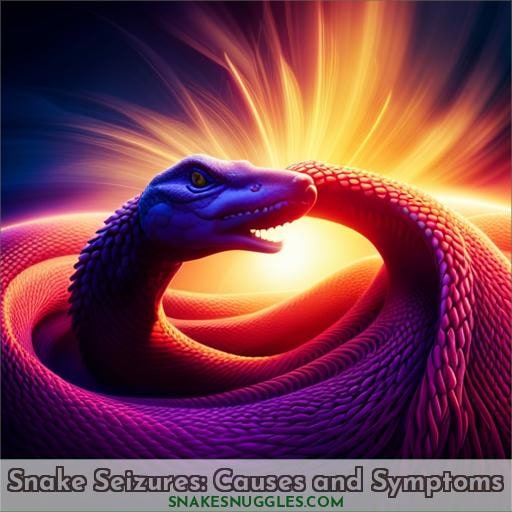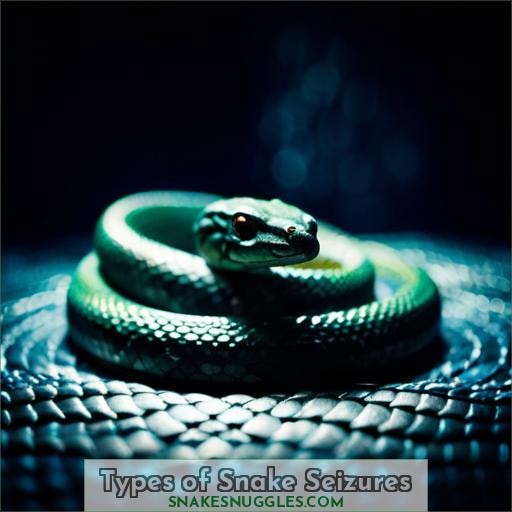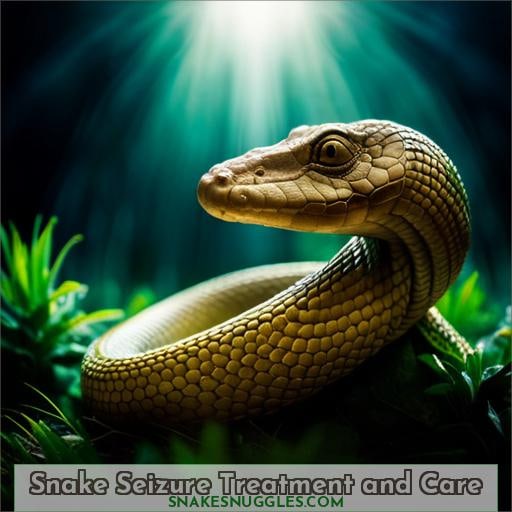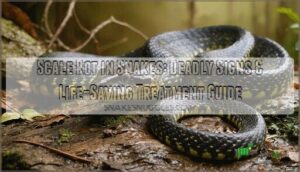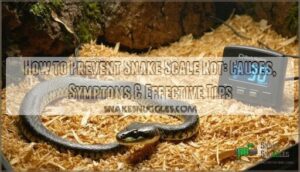This site is supported by our readers. We may earn a commission, at no cost to you, if you purchase through links.
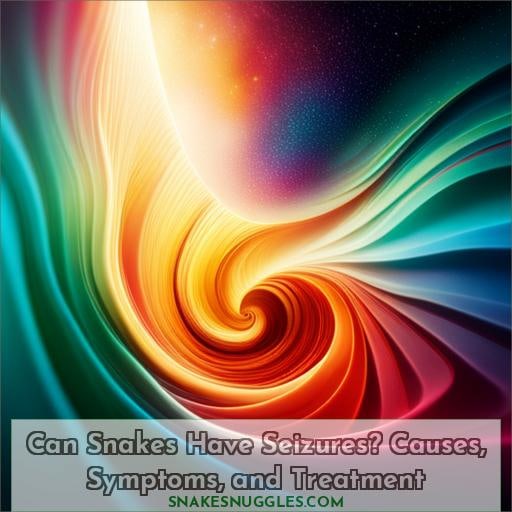 At a loss when your snake starts twitching? Can snakes have seizures? The short answer is yes. Seizures in snakes can be caused by neurological problems, inclusion body disease (IBD), and dietary or environmental factors.
At a loss when your snake starts twitching? Can snakes have seizures? The short answer is yes. Seizures in snakes can be caused by neurological problems, inclusion body disease (IBD), and dietary or environmental factors.
Though the thought of it may make you feel like burying your head in the sand, understanding what kinds of seizures are common for snakes — from head wobbling to stargazing — as well as how to treat them will help give you peace of mind.
To really get on top of this situation and keep your scaly friend safe and sound, seek out veterinary guidance right away – they’re just itching to help!
Table Of Contents
Key Takeaways
- Snakes can experience seizures due to neurological problems, IBD, or environmental factors.
- Proper enclosure temperature regulation is crucial to prevent seizures.
- Dietary factors like thiaminase in fish can cause seizures in snakes.
- Snake seizures should be addressed by seeking immediate veterinary guidance.
Snake Seizures: Causes and Symptoms
Snake seizures can be caused by a variety of neurological problems and environmental factors, such as Inclusion Body Disease (IBD), dietary issues, or overheating. To ensure that any seizure-related symptoms in your snake are addressed properly, it is important to understand what causes these episodes and the signs to look out for.
Neurological Problems
You may not be aware, but neurological issues can cause seizures in snakes and lead to symptoms like corkscrewing and stargazing. Genetics or stress may be the primary culprits behind these spasms. Trauma, venom exposure, and vitamin deficiencies also contribute to seizure activity.
Inclusion Body Disease (IBD) is a severe condition that often leads to spasmic behavior in boas and pythons. Overheating can damage nerves over time too, leading to shakiness or wobbling of the head, which is seen mostly among spider ball pythons.
The best approach for dealing with snake seizures is consulting your vet for guidance on making your pet more comfortable while managing its underlying issue(s).
Inclusion Body Disease (IBD)
IBD is a neurological issue in boas and pythons that can cause seizures, spasms, and other symptoms. It’s believed to be caused by a virus or bacteria, which leads to loss of movement control as well as behavioral changes.
Management of IBD should involve supportive care, such as providing comfortable temperatures, reducing stressors, and avoiding potential seizure triggers like sudden trauma or diet changes. Genetic factors are also sometimes linked with IBD; however, it can remain dormant for long periods before presenting itself in the form of seizures.
If you believe your snake may have this condition, seek professional veterinary advice immediately so they can provide guidance on how best to manage their health going forward.
Dietary Factors and Overheating
Aside from IBD, dietary factors such as thiaminase found in fish can cause seizures in snakes.
Heat sensitivity is another factor to consider; overheating could result in burns or neurological damage over time. Make sure your snake has a proper environment with optimal temperature ranges for its health and safety.
Stress management is also important to keep illnesses at bay since stress can trigger or worsen existing conditions like seizures.
Knowing the signs of illness will help you determine when your snake needs medical attention: vomiting, anorexia, abnormal shedding all point to potential issues that a vet should assess further!
Types of Snake Seizures
When it comes to snake seizures, there are three types of spasms that can occur. These include head wobbling, corkscrewing, and stargazing. Head wobble is common in spider ball pythons and causes a loss of coordination, while corkscrewing indicates an issue such as IBD or overheating, which leads to the snake losing control over its body movements.
Stargazing, likewise related to IBD, involves the snake looking upwards involuntarily.
Head Wobbling
Head wobbling is a type of neurological issue that can make your snake’s head shake involuntarily. It’s commonly seen in spider ball pythons and affects their coordination. The severity of head wobbling usually depends on the genetics involved, with more gene-related issues leading to worse tremors.
The reptile nervous system has difficulty controlling these involuntary movements due to an underlying problem or injury. Stress often worsens head wobbling, so providing proper housing and care is essential for snakes experiencing this symptom as part of seizure activity or other disorders like Inclusion Body Disease (IBD).
Watching for signs such as unbalanced body movements may be helpful in detecting worsening conditions. Early detection could help reduce symptoms before they become serious health risks.
Corkscrewing
Corkscrewing is a severe seizure type characterized by the snake’s body twisting and curling uncontrollably. Causes vary from trauma or falls to genetic diseases like IBD, spider morphs, and head wobbling.
Overheating can also lead to corkscrewing in some species. Management includes stress reduction, while prevention focuses on proper housing for pet snakes, along with regular vet check-ups for early detection of any underlying issues.
Venomous bites should be avoided as they may induce neurological problems leading to seizures.
Stargazing
Stargazing in snakes is a severe type of seizure characterized by an involuntary upward gazing and usually linked to Inclusion Body Disease (IBD). One in five boa constrictors have been reported to experience this kind of spasmic behavior.
Stargazing can be triggered by sudden trauma, heat, or stress. Diagnostic methods include blood tests and imaging scans for respiratory disease or IBD confirmation. Care techniques, such as proper enclosure temperature regulation and regular vet check-ups, are essential preventive measures against seizures like stargazing.
Stress should be minimized through careful handling practices, and nutritional guidance from experts may also help reduce the risk of neurological issues associated with the condition.
Seeking Veterinary Guidance for Snake Seizures
If you notice any abnormal behavior in your snake, such as twitching or loss of movement control, it’s important to seek out veterinary guidance. Medical assistance is necessary for diagnosing the underlying cause and providing treatment recommendations.
Here are some reasons why seeking professional advice can be beneficial:
- Veterinary Support: A vet can provide expert advice on the best course of action to take based on signs and symptoms of a possible seizure or other neurological issues like IBD.
- Professional Consultation: An experienced vet will have knowledge about snake diseases that could help identify potential causes behind seizures or spasms more accurately than an owner alone could do.
- Expert Advice: It’s essential to get medical assistance when considering treatments like vitamin B1 injections for garter snakes with thiaminase-related seizures, medications for septicemia caused by stress, or housing modifications around spider ball python head wobbling behaviors.
Seeking veterinary guidance is crucial when pet snakes exhibit unusual behavior due to health problems, such as respiratory diseases that can cause wheezing and open-mouth breathing, as discussed in common snake diseases. Seeking veterinary guidance is paramount ensuring proper care and well-being for your pet snake when unusual behavior occurs due to health problems.
Snake Seizure Treatment and Care
It is important to understand and address the underlying causes of snake seizures, as well as making dietary changes, regulating temperature levels, and providing appropriate care. Managing these issues is essential in order to reduce or stop seizure activity in snakes.
Managing Underlying Issues
Managing any underlying issues that can be causing your snake’s seizures is essential for their health and well-being. Genetic factors, parasites, mouth rot, Inclusion Body Disease (IBD), diet, and skin infections should all be considered when assessing the cause of a seizure.
If any of these are present or suspected to potentially play a role in your snake’s condition, then behavior modification techniques can help reduce stress levels, which often exacerbate neurological symptoms.
Additionally, environmental enrichment methods such as providing more hiding places or adding items like vines to climb may aid in alleviating some pressure on the nervous system too. Medication consideration may also provide further relief from spasms, but consulting with an experienced vet first is recommended as they will have an understanding of how best to treat each case individually if necessary.
Dietary Changes
Making dietary changes can help alleviate some of the symptoms associated with seizure-inducing conditions in snakes. Thiaminase, a toxin found in certain fish, is known to cause seizures when consumed by garter species.
To reduce the risk, mealtime modifications and nutritional adjustments may be necessary.
Vitamin therapy has been used to counter thiaminase effects; however, other dietary triggers such as venom or cryptosporidiosis should also be considered for spider morph species.
By maintaining regular vet visits and ensuring proper nutrition through diet changes if needed, owners can support their snake’s health while reducing potential risks related to seizures from malnutrition or other sources.
Temperature Regulation
To ensure your snake’s well-being, regulating its temperature and creating a safe environment is absolutely essential – it’s like giving them the royal treatment! Careful heat management helps snakes maintain their body temperature.
Thermal needs vary depending on species, so be sure to research reptile thermoregulation.
Providing environmental control with heating lamps or heated pads can help keep temperatures consistent for optimal health:
- Place heating lamps at one end of the enclosure for basking areas up to 10°C higher than ambient temperatures.
- Keep an eye on the thermometer as some bulbs are more powerful than others.
- Position hide spots away from direct light/heat sources and provide substrate insulation material if necessary.
Properly managing your snake’s thermal needs goes hand in hand with understanding their behavior – monitoring heat levels within enclosures will make life easier for both you and your scaly friend!
Extraordinary Case: Snakes Detecting Seizures
Amazingly, an extraordinary case exists where a boa constrictor was able to detect seizures and communicate it by squeezing its owner’s neck. This gave the man from Washington time to find a safe place before having any episodes.
The connection between this snake and its human companion is unlike anything seen in conventional pet relationships. It raises questions about wearing such reptiles around one’s neck all day, but it also shows that snakes are more than just pets; they can be companions who look out for your safety as well as provide comfort when needed.
The ability of this boa constrictor to sense seizures is remarkable not only because of the unconventional way he communicates them but also because humans have never been known for their alertness towards seizure warnings beforehand or during an episode itself – making his actions even more startlingly useful!
Could other people benefit from similar experiences? Perhaps with further research into human-snake connections, we could discover how these animals can help us create better systems for detecting seizure onset so that we may protect ourselves if ever in danger again, thanks to our unlikely partners: Boas!
Conclusion
Unbelievably, snakes can actually experience seizures, with symptoms ranging from mild to severe. It’s important to take snake seizures seriously and understand the underlying causes, which can range from neurological problems to dietary issues or overheating.
The most common types of seizures in snakes are head wobbling, corkscrewing, and stargazing. For proper treatment and care, it’s best to consult a vet for guidance. Depending on the situation, management of underlying issues, dietary changes, and temperature regulation may be necessary.
In one extraordinary case, a boa constrictor was even able to detect seizures and alert its owner – a story that raises many questions. Ultimately, understanding the causes and symptoms of snake seizures can help owners better care for their pets and keep them safe.

